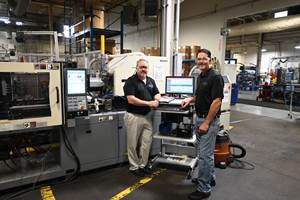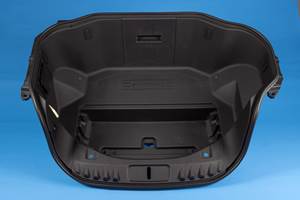Body Exterior and Interior SPE Auto Innovation Awards Finalists
LED headlamps, a deployable shelf and a console carrier are some key applications from this year’s contest.
I recently reported on the grand award winner (body exterior) and the winner of the other eight categories of the 2017 SPE Automotive Innovation Awards. Having participated as one of the judges for the third year in a row, I have been impressed by nearly all of the finalists and would like to highlight some of the other applications that merit mention. In this case, take a look at some of the interesting body exterior and body interior finalists. In the case of the former, it was no surprise to see that headlamp LED technology continues to evolve, with two finalists sporting new technologies.
Body Exterior
β D Optic LED Headlamp: Featured on GM’s 2018 Chevy Traverse crossover utility vehicle, this innovative headlamp system features scalable modular design flexibility. It is injection molded by Magna Autosystems using Plexiglas HY-121 PMMA from Arkema. Customers can add elements to achieve styling and/or performance objectives. The lenses are single-shot thick molded elements, with extremely tight tolerance and high optical clarity requirements. They simplify conventional optical systems in which multiple components (reflector, shield and lens) must be positioned very precisely, with a system of pairing a precisely molded lens with a single 1 x 1 LED light source. Arkema’s high-temperature grade acrylic enables the modular lenses to be placed very close to the light source, within 300-500 microns, to maximize the amount of light captured from the LED. The Traverse headlamp has three vertically large integrated lenses alongside six individual compact lenses.
β Headlamp Light Curtain: Featured on GM’s 2016 Cadillac CT6 luxury sedan, this lamp, is injection molded by Hella KGaA Hueck & Co. with Evonik Cyro LLC’s Acrylite LD96 PMMA. It appears crystal clear when unlit but has a glowing appearance when lit. The light scattering properties of the new material convert the light guide to a fully-illuminated panel, that can be used with any color LED, opening a new degree of freedom for designers.
Previously, clear PMMA without this light-scattering additive was used, and structures on the surface of the light pipe, along with multiple LEDs behind the part, had to be applied. These traditional light guides and light pipes resulted in bright spots and a milky (grained) unlit appearance. The new headlamps provide premium headlamp styling due to a homogeneously lit light function. Safety is enhanced as there is better visibility due to a larger illuminated surface easier to detect with the human eye. A 3D effect can also be achieved.
Body Interior
β Thin-Wall Floor Console Carrier: Featured in GM’s 2018 Buick Enclave and Chevy Traverse SUVs, the part is injection molded by NYX using Celstran 40-0453 from Celanese. This flood console carrier is unique with its 2.0 mm nominal thin-wall thickness (with ability to implement lightening holes); 40% long-glass-fiber PP construction; and top quality surface appearance. A 30% mass savings resulting in a 2.2 lb/.99 kg weight savings, and a 15% cost savings was achieved. Lateral stiffness targets were exceeded eliminating the need for metal brackets. Moreover, this is also the first time injection molding was used to process this type of component.
β Cargo Management Deployable Shelf: Featured in Ford’s 2018 Expedition and Lincoln Navigator Luxury SUVs, this part is injection molded by Valley Enterprises using PPH5TF2 from Washington Penn Plastic and ABS HI121 from LG Chem, distributed by Chase Plastics.
This first time use of multi-functional cargo management system in an SUV provides the customer with dynamic storage options in the rear of the vehicle. It enables the use of the full height of the cargo environment as well as assisting in solving the common customer complaint of items falling from the rear of the vehicle.The system’s bins, components and actuation linkages are injection molded using various PP and ABS materials to meet new appearance and load requirements.
Related Content
Atop the Plastics Pyramid
Allegheny Performance Plastics specializes in molding parts from high-temperature resins for demanding applications as part of its mission to take on jobs ‘no one else does.’
Read MoreGlass Fiber-Reinforced PP With PCR For Automotive
Borcycle GD3600SY will appear in Peugeot vehicles.
Read MoreTrinseo Starts Up PMMA Depolymerization Facility
The Italian facility’s chemical recycling process returns acrylics, including PMMA sheets, to monomer methyl methacrylate (MMA)
Read MoreAutomotive Awards Highlight ‘Firsts,’ Emerging Technologies
Annual SPE event recognizes sustainability as a major theme.
Read MoreRead Next
Making the Circular Economy a Reality
Driven by brand owner demands and new worldwide legislation, the entire supply chain is working toward the shift to circularity, with some evidence the circular economy has already begun.
Read MoreSee Recyclers Close the Loop on Trade Show Production Scrap at NPE2024
A collaboration between show organizer PLASTICS, recycler CPR and size reduction experts WEIMA and Conair recovered and recycled all production scrap at NPE2024.
Read MoreBeyond Prototypes: 8 Ways the Plastics Industry Is Using 3D Printing
Plastics processors are finding applications for 3D printing around the plant and across the supply chain. Here are 8 examples to look for at NPE2024.
Read More














